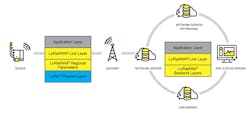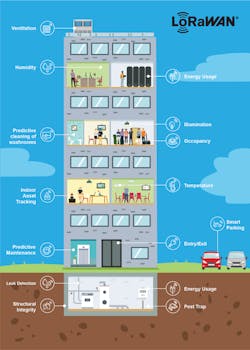Extend Building Automation and Control with LoRaWAN
What you’ll learn:
- How LoRaWAN can extend existing BACnet systems for cost-effective smart-building management.
- Three approaches to leverage BACnet and LoRaWAN concurrently,
Buildings and even entire campuses worldwide are being renovated and repurposed like never before to create healthier, more efficient, and sustainable environments. As systems evolve, they also place greater demands on building management systems (BMS), which handle everything from light, temperature, air, and water to security and servicing.
The global standard communications protocol for building automation and control (BAC) is BACnet. As with many legacy systems, BACnet is hardwired. Consequently, it’s expensive to install, hard to expand with respect to coverage, and even harder to add functionality that aligns with emerging building requirements that monitor the cleanliness of air, personal safety, room usage, and social distancing. However, the broad availability of low-power wide-area networks (LPWANs) offers an easy way to augment BMS functionality by combining BACnet and LoRaWAN technologies.
Managed by the LoRa Alliance, the LoRaWAN standard is the leading LPWAN protocol designed to wirelessly connect battery operated “things” to the internet in private, regional, national, or global public networks. It addresses key Internet of Things (IoT) requirements such as bidirectional communication, end-to-end security, mobility, and localization services.
LoRa Alliance members include technology leaders such as Amazon Web Services, Cisco, Microsoft, Orange, and Semtech, among many more as part of the largest IoT ecosystem. In the smart-building space, companies like Acklio, Setemi, Talkpool, Voytech, and Wattsense are at the leading edge of deploying LoRaWAN with BACnet. What follows reveals how they do it.
Understanding LoRaWAN
LoRaWAN networks connect devices such as sensors, actuators, and tags that communicate bidirectionally. The LoRaWAN network architecture (Fig. 1) is deployed in a star-of-stars topology whereby gateways relay messages between end-devices and a central network server. Gateways are connected to the network server via standard IP connections and act as a transparent bridge, converting RF packets to IP packets and vice versa.
The wireless communication takes advantage of long-range characteristics of the LoRa physical layer, allowing a single-hop link between the end-device and one or many gateways. All modes are capable of bidirectional communication. Furthermore, there’s support for multicast addressing groups to make efficient use of spectrum during tasks such as firmware updates over-the-air (FUOTA) or other mass-distribution messages.
A single LoRaWAN gateway can cover tens of thousands of square feet, eliminating the need for deployment of multiple access points or mesh points common in other wireless networking options. Power consumption is exceptionally low, allowing battery-powered devices to operate for up to 10 years without service.
LoRaWAN devices also have excellent range and transmission properties. This enables them to be deployed wirelessly throughout buildings of all kinds, to gather and distribute data. Devices don’t link to fixed infrastructure, so they’re easy to install and relocate. Communication through dense walls, elevator shafts, or basements is outstanding. Thus, considerably fewer LoRaWAN gateways are used than with other wireless options, which also makes deployments highly cost-effective.
Devices using the LoRaWAN standard are certified through the LoRa Alliance’s LoRaWAN Certification program to ensure that they deliver the expected performance and are fully interoperable with any other LoRaWAN infrastructure. Hundreds of millions of devices are now deployed in LoRaWAN networks across the globe.
LoRaWAN Extends BACnet Capabilities
LoRaWAN is well-known for consuming little power and covering vast areas—like entire cities or big farms or even wildlife parks. However, due to its ability to transmit through thick walls, and penetrate concrete and metal, it’s ideally suited for BMS use cases.
In helping to digitize building operations, LoRaWAN isn’t a replacement for BACnet, nor an alternative to it. Rather, LoRaWAN extends BACnet capabilities. When used with LoRaWAN, BACnet still specifies the functionality that’s enabled in a digitized BMS, e.g., acceptable inputs and outputs; networking; data generation and storage; and protocols to manage HVAC, elevators, lifts, fire safety and lighting systems, and more (Fig. 2).
Three approaches have been identified to combine LoRaWAN’s flexibility with BACnet’s infrastructure. Selecting an approach depends on multiple considerations, like the specific capabilities to be added, the need for scalability, and the importance of security, among others.
“BACnet over LoRaWAN”—or backhaul—is the first approach. LoRaWAN serves as the data channel to the control applications. It’s very easy to implement as no changes to the BACnet protocol, network, or BACnet-enabled devices and management systems are needed.
The second approach is to deploy LoRaWAN as a complementary network, focusing on integration with the BMS. The readout from IoT devices is presented to the BMS via an application programming interface, so the LoRaWAN data and sensors appear to be part of the BACnet system.
Finally, instead of integrating LoRaWAN and BACnet at the buildings and control level, the third approach uses data streams from both technologies that are combined in the analytics engine.
The following is a deeper look at each of these approaches.
BACnet over LoRaWAN
Two methods are employed to deploy the backhaul option. Both use standard BACnet sensors and actuators equipped with a compatible modem, which enables long-range wireless connectivity.
The first method involves enabling existing BACnet devices to communicate via LoRaWAN using BACnet over IP. Static context header compression (SCHC) firmware can be added directly to the BACnet device or supplied via an external bridging device. Note that the Internet Engineering Task Force has just published a new set of standards that codifies how SCHC adapts existing IP-based protocols to LPWAN networks, guaranteeing interoperability of multiple technologies, including LoRaWAN.
The second method involves adding LoRaWAN bridging via SCHC to a BACnet/IP router instead of at the device level. The router will manage sensor data and communicate with the BMS over LoRaWAN. All network elements appear as native BACnet devices but can be deployed at a much lower infrastructure cost than BACnet.
Complementary Networks and BMS Integration
In a complementary network, a LoRaWAN network is independent of the core BACnet infrastructure. The LoRaWAN network then feeds data to the BMS through a virtual BACnet server that makes any LoRaWAN device appear to be a BACnet device.
Due to the ease of deployment of LoRaWAN devices and the fact that they don’t need to be connected to a building’s electrical system, new sensors can be added in locations not readily available to BACnet systems. This eliminates the need for expensive retrofits, as the BMS perceives data from the LoRaWAN devices as BACnet.
Cloud Integration
A third approach is to install a LoRaWAN network fully independent of the BMS and BACnet systems. Integration is provided at the analytics layer, leveraging data from all sources.
Conclusion
Although facilities management teams have been exploring smart-building applications for many years now, the advent of COVID-19 and desire to safely bring employees and customers back to the office is driving rapid adoption of IoT technologies. Leveraging LoRaWAN and BACnet allows facilities to extend, reconfigure, and enhance complex built environments at lower cost, but with greater capabilities. Using new technologies to extend legacy BMS systems will accelerate a transition to healthy, sustainable buildings in a way not previously seen.
Learn More
For developers wanting to learn more about the LoRaWAN standard, ecosystem, and resources, an excellent place to start is the LoRa Alliance website. The section on “Buildings” provides use cases, white papers, and webinars specific to building automation and control. You can also get the standards documents on the Developer pages.
Acknowledgement
Many thanks to the LoRa Alliance Smart Buildings Workgroup members who contributed to this article.
References
- https://gateway.on24.com/wcc/eh/2820560/lp/3141559/sustainable-smart-buildings-of-the-future (on demand webcast)
- https://gateway.on24.com/wcc/eh/2820560/lp/3490975/taking-your-building-digital-with-lorawan (upcoming webcast - Nov. 16, 2021)


